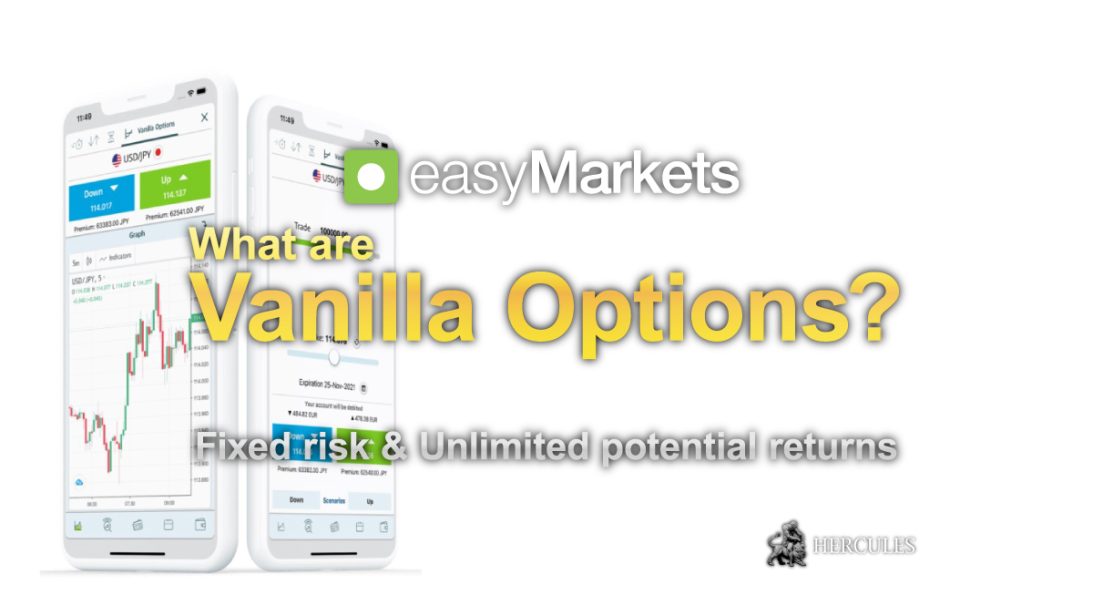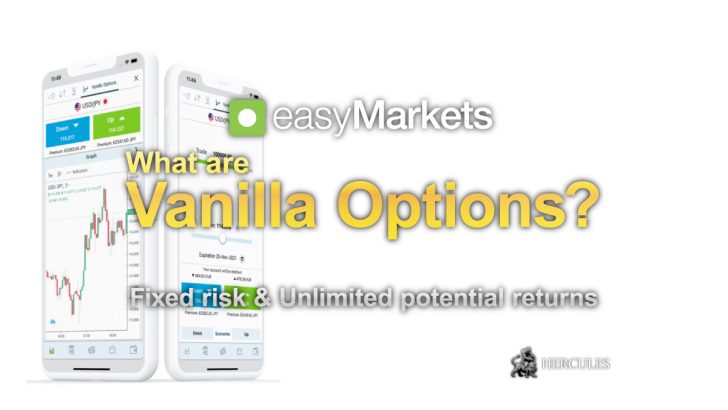How to get started? Trading Vanilla Options with easyMarkets !
Vanilla options, available on the easyMarkets platform, are financial instruments that allow traders to speculate on market dynamics or hedge against potential losses, with various strategies and insights provided by tools like ‘The Greeks’.


An Introduction to Vanilla Options
Vanilla options have emerged as versatile financial instruments cherished by traders, owing to their inherent qualities suitable for both hedging against potential losses and speculating on various market dynamics. One could speculate on parameters ranging from future exchange rates to the intricate nuances of price volatility. As you delve deeper into the world of options, you’ll come to understand the significance of speculating on the direction of an underlying asset’s price. If you’re bullish about the future prospects of an asset and anticipate a rise in its price, you’d naturally gravitate towards buying a “Call” option. In stark contrast, a bearish outlook on the asset, expecting its price to plummet, would make the purchase of a “Put” option more appealing.
Trade Vanilla Options with easyMarkets
The Essence of Options: Rights and Obligations
One of the foundational aspects of grasping the concept of options is recognizing that they offer the right – but critically, not an imposition – to procure an underlying asset at a predetermined price, known as the strike price, at some point in the future. Taking the vast realm of forex trading as a classic illustration, the underlying asset in this context is a specific currency. This article endeavors to equip you with the fundamental knowledge required to embark on a journey of trading options, using the intuitive easyMarkets platform as a stepping stone.
Decoding the Core Attributes of Options:
- The Interplay of Buyers and Sellers:
- Behind every option that sees a transaction, there’s a dance of two parties – a buyer and a corresponding seller. In the lexicon of options, the buyer is often referred to as the holder, while the seller assumes the title of the writer.
- A Safety Net for Traders:
- The allure of forex options lies in their inherent ability to act as a buffer, offering traders a safeguard against the unpredictable ebb and flow of exchange rates.
- Harnessing Potential and Flexibility:
- Options present a dual-fold advantage to traders. They can deftly use them to hedge against looming financial uncertainties or craft trades that mirror their forecasts about market movements.
Go to easyMarkets’ Official Website
Various Options and Their Financial Implications
1. BUY CALL (UP)
Embracing this option signifies your conviction that a currency pair’s price is on an upward trajectory. Let’s contextualize this with a scenario:
Assume you’ve invested in an option tied to the EUR/USD pair, boasting a strike price of 1.3900, in return for a premium of $10. Should the EUR/USD rate languish below 1.3910 as the option reaches its expiration, invoking the option wouldn’t be a prudent financial move. Yet, if the price manages to eclipse this threshold, say, settling at 1.3940 upon expiration, a neat profit of $30 would be your reward.
Open an account with easyMarkets
2. BUY PUT (DOWN)
This option is your best bet when the winds seem to hint at a decline in a currency pair’s price. Here’s a hypothetical situation to elucidate:
Visualize a scenario where you’ve acquired a Put option connected to the EUR/USD duo, stamped with a strike price of 1.3890, at the cost of a $10 premium. If the grand finale, i.e., the expiration date, sees the exchange rate hovering above 1.3880, it’s in your best interest to let the option lapse, forfeiting just the premium. But a twist in the tale, wherein the price dips to 1.3860, allowing you to purchase at this rate and subsequently offload at 1.3890, translates to a $20 profit, even after accounting for the premium outlay.
It’s paramount to realize that with Vanilla Options on the easyMarkets platform, you’re spared the complication of procuring the spot. Instead, your account balance witnesses an adjustment, reflecting the net cash upon the option’s expiry.
Go to easyMarkets’ Official Website
Demystifying the Pricing of Options: The Premium Conundrum
A melange of factors converges to dictate the premium of an option. This includes the prevailing exchange rate, the whims of interest rates, the pulse of volatility, the all-important strike price, and the ticking clock signaling the time left until the option’s expiration.
Trade Vanilla Options with easyMarkets
Time Value and Intrinsic Value Decoded:
- Intrinsic Value:
- Come expiry, this is essentially the gap between the strike price and the spot rate.
- Time Value:
- Think of this as the delta between the option’s premium and the intrinsic value it commands.
Open an account with easyMarkets
Categorizing Options Based on Money-ness
Options can be neatly pigeonholed into:
- In the Money (ITM):
- These options are imbued with intrinsic value.
- At the Money (ATM):
- Bereft of intrinsic value, here the strike price is on par with the prevailing market rate.
- Out of the Money (OTM):
- These too lack intrinsic value, but with a catch – the strike price isn’t quite in sync with the current market valuation, often to the holder’s detriment.
Go to easyMarkets’ Official Website
Navigating Risk with ‘The Greeks’ as Your Compass
For those aiming to master the higher echelons of option trading, getting acquainted with the Greeks isn’t a luxury but a necessity. They serve as barometers, offering insights into the fluctuations of an option’s premium:
- Delta:
- Deciphers the oscillations in an option premium in tandem with shifts in the price of the underlying entity.
- Gamma:
- A measure of how Delta evolves as the price of the underlying asset undergoes changes.
- Vega:
- A testament to the repercussions of volatility shifts on the option’s premium.
- Theta:
- Sheds light on how time decay gnaws away at the premium.
- Rho:
- A gauge of the ripple effects interest rate modifications have on the premium.
Trade Vanilla Options with easyMarkets
Crafting a Game Plan: Strategies Tailored for Options
A couple of strategies have gained prominence among traders:
- Long Straddle:
- Ideal for times when you sense heightened volatility but are on the fence regarding the asset’s price trajectory. It entails acquiring both an ATM Call and a Put.
- Long Strangle:
- This strategy shares the sentiment of banking on robust volatility but diverges in its approach, favoring OTM options to slash premium expenditures.
Options Trading with EasyMarkets
The easyMarkets platform is lauded for its intuitive design, which makes option trading a breeze, even for novices. Embarking on your trading journey involves a few straightforward steps:
- Pinpoint your desired currency pair.
- Ascertain the amount you wish to stake.
- Lock in your strike price.
- Mark the calendar with your chosen expiry date.
- Zero in on the direction, be it Up or Down.
Equipped with this comprehensive overview, you stand poised to navigate the intricate maze of vanilla options trading on the easyMarkets platform. However, a word of caution: trading, in all its forms, is akin to a double-edged sword, fraught with risks. Tread with caution, and always prioritize informed decision-making.
Trade Vanilla Options with easyMarkets
FAQs about Vanilla Options and easyMarkets
- What are options in trading?
- Options are financial instruments that give you the right, but not the obligation, to buy an underlying asset at a specific price in the future. The specific price is called the strike price.
- How can options be used in trading?
- Options can be used to speculate on future exchange rates or price volatility. Traders can buy a “Call” option when they predict a rise in the underlying asset’s price or a “Put” option if they expect a decline.
- What are “Call” and “Put” options?
- A “Call” option allows the holder to profit from an increase in the price of the underlying instrument. Conversely, a “Put” option allows the holder to profit from a fall in the asset’s price.
- What are currency or forex options?
- Currency or forex options allow traders to protect themselves from undesirable moves in exchange rates, serving as a hedging tool or as a speculative trading method.
- How is the premium of an option determined?
- The premium is influenced by factors such as the current exchange rate of the underlying currency pair, interest rates, volatility, the strike price, and the time until expiration.
- What’s the difference between option premium and stop loss in the spot market?
- An option premium is an upfront payment made to hold the option. With options, traders benefit from the time dimension, allowing the position to potentially come into profit even if the spot exchange rate moves adversely. In contrast, a stop loss in the spot market immediately closes a position at a loss when the specified rate is reached.
- What does “In the Money,” “At the Money,” and “Out of the Money” mean?
- “In the Money” means the option has intrinsic value. For Call options, this is when the strike price is below the current spot price, and for Put options, it’s when the strike is above the spot price. “At the Money” is when the strike price is the same as the current market price. “Out of the Money” means the option has no intrinsic value.
- How do option strategies like Long Straddle and Long Strangle work?
- A Long Straddle strategy involves purchasing both a Call and a Put option at the same strike price (at-the-money). It profits from high volatility in a currency pair. The Long Strangle strategy also banks on high volatility but involves buying out-of-the-money Call and Put options, leading to reduced premium costs.
- What are ‘The Greeks’ in options trading?
- ‘The Greeks’ represent quantities used to forecast the risk attached to an option contract over time. They include Delta (how the option premium changes with price), Gamma (how Delta changes with price), Vega (effect of volatility on premium), Theta (effect of time on premium), and Rho (effect of interest rates on premium).
- How can one trade options on the easyMarkets Platform?
- Upon logging into the web trading platform, users can select the Vanilla Options tab to trade options. The platform interface allows for the purchase of Call or Put options with predefined strike prices, amounts, and expiry dates.












